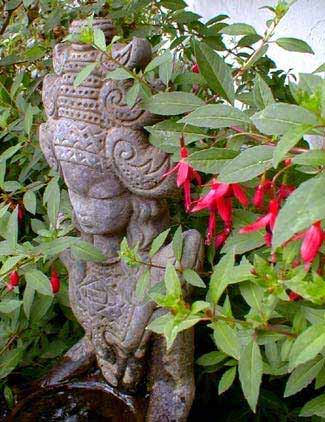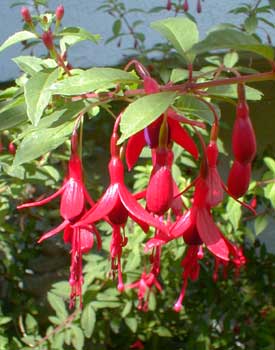
'Little Giant'
Hardy Fuchsia
"My Fuchsia's Coral Seams
Rip -- while the Sower -- dreams"
-Emily Dickinson
(1830-1886)
(1830-1886)
I presume this cultivar is derived from F. magellanica, though invariably sold without species name as 'Little Giant.'
It was initially planted on a cliff edge in deep shade, at the far rear of what amounts to a trillium & jack-in-the-pulpit garden. As it was a sharply draining ledge, the area was occasionally too dry. This location turned out to be overly dark even for a shade-tolerant hardy fuchsia. For two years I pondered moving it to a sunnier location, but kept putting it off.
It bloomed until late into Autumn even in the deep-shade location, but flowers were always sparse, & leaf development was thin. So in October (2002) it was still in bloom when I did finally move it to a somewhat sunnier spot, & replaced it with a dwarf Oregon Grape (Mahonia repens) which likes that previous location much, much better.
 This subshrub has a mild winter presence if it doesn't get too cold, but was mostly leafless shortly after the stress of having been moved. Very early in spring, it again became leafy. It was much more pleasing in appearance than ever it had been in deep shade.
This subshrub has a mild winter presence if it doesn't get too cold, but was mostly leafless shortly after the stress of having been moved. Very early in spring, it again became leafy. It was much more pleasing in appearance than ever it had been in deep shade.In its brighter dappled-sun location 'Little Giant' was no longer restricted to a few blooms scattered over a struggling little shrub. It began to flourish as it had never done previously, & doubled in size throughout the spring, became very leafy, then began producing a great many flower buds by May, flowering happily by June.
The small single-blossoms have red sepals & blue-violet corollas, everblooming from June or July to at least October. The photo above shows it in July 2003 peeping from around an apsaras (nymph goddess); the second photo is from July 2004.
Its growth habits entirely changed, too. During its two years in the too-shady depths, it had grown only one foot high & crept to three feet wide, behaving almost as a creeper as it sought more sunlight. Though it's a dwarf variety, the cultivar is not supposed to be a creeper, & with more sun it became a more upright or fountaining shrub, its stems sweeping to three or four foot height & width.
This is a perfect fuchsia for the Pacific Northwest. It is semi-evergreen here, & develops a woody structure over time, requiring a bit of pruning in spring for appearance sake & to keep it compact.